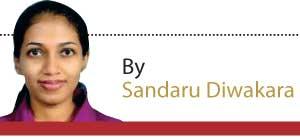Reply To:
Name - Reply Comment
- The prominence given to English and how it becomes significant to achieving better careers and education opportunities are visible in most post-colonial nations
- One of the major suggestions of the book is to make the classroom a safe zone that can help project positive attitudes towards learning English, where shyness and anxiety could be combated
- Findings demonstrate the unmistakable influence of the attitudes found in the larger society outside the English language domain, in addition to the influence of the attitudes found in the ‘inner society’ that is the English language classroom
The British Empire was the most powerful empire in recent history, ruling over half the world at one point. One of its main outcomes was the establishment of English as the dominant  Lingua Franca, where its mastery ensured elevated standards of living and status. As Dr. Asantha Attanayake Barborich states, while nationalism and prioritising national languages were focused on by the colonized countries in the immediate post-independence periods, “as the time went on, they have meekly accepted the global dominance of English and have come to terms with it.”
Lingua Franca, where its mastery ensured elevated standards of living and status. As Dr. Asantha Attanayake Barborich states, while nationalism and prioritising national languages were focused on by the colonized countries in the immediate post-independence periods, “as the time went on, they have meekly accepted the global dominance of English and have come to terms with it.”
So, the prominence given to English and how it becomes significant to achieving better careers and education opportunities are visible in most post-colonial nations. Therefore, English holds a significant place within the education systems and different curricula are employed by different post-colonial nations. Yet, only a low percentage manages to reach full competency in English, specifically in speaking, despite numerous years of education they receive in school, universities, colleges and other higher education institutions.
For instance, the Education Ministry states, “when it comes to the Sri Lankan education system, English is being taught almost over 11 years as a core subject but the student performance is not at a very satisfactory level.” According to Dr. Attanayake, this phenomenon is common to many South Asian post-colonial countries.
 The book ‘Post-Colonial Curriculum Practices in South Asia: Building Confidence to Speak English’ by Dr. Asantha U. Attanayake tries to navigate within this context. The book is based on studies carried out in Bangladesh, India, Pakistan and Sri Lanka with the participation of 4630 participants.
The book ‘Post-Colonial Curriculum Practices in South Asia: Building Confidence to Speak English’ by Dr. Asantha U. Attanayake tries to navigate within this context. The book is based on studies carried out in Bangladesh, India, Pakistan and Sri Lanka with the participation of 4630 participants.
The author is a Senior Lecturer in English Language at the Department of English Language Teaching in the Colombo University. As she states, “Teaching English specifically to learners in the former British colonies of South Asia is an unexplored area because… a teaching methodology has not been designed to address the issues arising from certain prevalent social attitudes and their influence on English Language Teaching (ELT)”.
According to Dr. Attanayake, one of the core issues faced by learners of English in South Asian post-colonial nations is the ‘lack of confidence to speak English’, for fear of ridicule. This lack of confidence is created from within the English language classroom and also from the students’ outside environment.
The author terms this as ‘inside society’ and ‘outside society’, where she states the, “Findings demonstrate the unmistakable influence of the attitudes found in the larger society outside the English language domain, in addition to the influence of the attitudes found in the ‘inner society’ that is the English language classroom.
” Therefore, it becomes a two-way process that can negatively or positively influence the learner. Given the findings of this study, it is evident that both the ‘inner society’ and ‘outer society’ negatively interacts with the speaker in most occasions, making them anxious to speak.
Elaborating further, Dr. Attanayake has developed a theoretical perspective called Language Attitude Anxiety (LAA). It is “caused by the existing specific societal attitudes towards a language and its speakers, which affects learners in their language performance, which in turn affects the entire learning process…[it is] a specific kind of anxiety that inhibits a person from speaking in a language due to shyness and/or fear of being negatively evaluated in society or due to a dislike or hatred of the target language.
” The danger of LAA is the way these negative attitudes of the inner and outer society could be projected, ensuring the continuation of a negative cycle. Therefore, the teacher in the ELT classroom has a crucial role to play, where they are supposed to propagate positive attitudes within students. Also the book proposes an academic discourse namely Language Attitudes be introduced to the academia as an independent discipline. As such, this book is more appropriate to teacher training institutions, universities, colleges, other higher education institutes and the Ministries of Education of the South Asian post-colonial nations.

"One of the core issues faced by learners of English in South Asian post-colonial nations is the ‘lack of confidence to speak English’, for fear of ridicule - Dr. Asantha U. Attanayake"
Dr. Attanayake elaborated the teaching methodology, teacher’s role, evaluation methods and the way these findings could be further incorporated into the academic discourse. One of the major suggestions of the book is to make the classroom a safe zone that can help project positive attitudes towards learning English, where shyness and anxiety could be combatted. Group oriented work with no individual work, without explicit error correction or grammar teaching are some of the ways suggested by the author as the features of a safe zone.
She also emphasises the mother tongue should not be used in the English language classroom. Since these new concepts could be quite challenging to implement within a classroom, the author acknowledges that the duties “expected of teachers in the confidence building classroom are different from the duties found in an ordinary classroom.” So, proper teacher training to address these requirements is something necessary according to Dr. Attanayake.
Since the methodologies implemented by South Asian post-colonial countries to teach English seem to be failing, as per the examination results as well as the obvious observations, piloting a project with these new ideologies could prove to be beneficial. As the author states “Building Confidence to Speak English is proposed as a rectifying measure to embark on teaching English in an innovative way, in contrast to the traditional, conventional and stereotypical methods that have failed our learners… Learners’ confidence to speak, in any English they are able to, is built, first within the four walls of the language classroom so that their confidence is projected outwardly to ignore the watchdog waiting in society ever since the colonial master left these nations.”